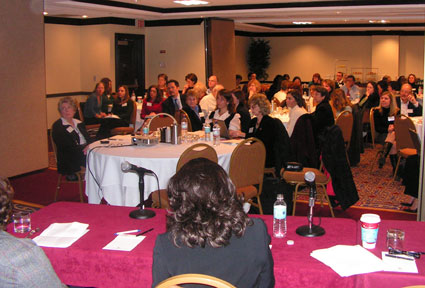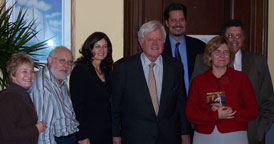Sibling Leadership Network: Report from November 2007 Conference
January 14, 2009
Beginning with a series of meetings in the Fall of 2006 to develop its mission, purpose, and values, the Sibling Leadership Network (SLN) convened for the first time on November 9 and 10th, 2007. Over 80 brothers and sisters of individuals with intellectual and developmental disabilities, researchers, policymakers, self-advocates, funders, and other committed professionals in the disabilities field attended the conference. The group discussed services and supports, policy advocacy, and research, and created three White Paper Working Groups that over the next twelve months will delineate issues and make recommendations for change. Their ultimate goal is to create opportunities for siblings to partner with government and service providers to ensure the highest quality of life, now and in the future, for their entire families.
Convening and Governance
The event was sponsored by the Rehabilitation Research and Training Center on Aging with Developmental Disabilities and the Kennedy Center at Vanderbilt University. The meeting was convened by a steering committee composed primarily by representatives from The Institute on Disability and Human Development at The University of Illinois at Chicago, The Kennedy Center at Vanderbilt University, The Nisonger Center at The Ohio State University and the Sibling Support Project of the United States. The steering committee will continue to provide leadership and coordination of activities, including coordinating the three White Paper Working Groups throughout the year.
 |
| Attendees at the 2007 Sibling Leadership Network meeting listen to speakers |
Presentations
During their two days together, SLN conference attendees heard substantive, insightful, and inspiring presentations from a wide range of experts. Topics included: Reviewing and Ratifying the Mission, Purpose, and Values of the SLN, Sibling Issues Across the Lifespan, Future Planning Issues, Federal Agency Perspectives on Research, an International Roundtable, and Leaders' Perspective on Policy.
Since the Conference
 |
| L-R: Essie Pederson, Marvin Moss, Tamar Heller, Senator Kennedy, Michael Henn, Cathy Allen and Tom Fish |
Steering committee representatives have presented summaries of the information to other interested groups, created listserv methods of communication between members of the working groups, shared photographs online, debriefed the conference with members of SibNet, and provided follow up communication with important policy makers on Capitol Hill and at the state and local levels.
resulting White Paper
The Sibling Leadership Network: Recommendations for Research, Advocacy, and Supports Relating to Siblings of People with Developmental Disabilities (September 15, 2008) [ ![]() , 385K]
, 385K]
White Paper Working Group
A workgroup crafted wthe paper with the following policy, research, and services/supports emphases.
Policy
Principles
Because the sibling relationship has the potential of being one of our longest existing relationships,
- We believe that the term "family" should include siblings, and anyone else that an individual with a disability considers family
- We believe that siblings have a unique and under represented voice in advocacy for and with their brothers and sisters with disabilities
- We believe that all family members have a right to family support that enhances the quality of life for all members
- We believe that there are millions of siblings who are an untapped resource who can, with the proper support and encouragement, make a positive impact in the lives of their brothers and sisters and others with disabilities
Action Steps
- Seek to include the word "sibling" in the federal Developmental Disabilities Act by including siblings on all Developmental Disabilities Councils and providing funding to support sibling programs
- Define other organizations across the nation with whom it would be advantageous to partner
- Identify key decision makers to whom to distribute the white paper, and then distribute it
- Create a concise, consistent message that we can then communicate to decision makers as well as other siblings and interested parties to communicate to their legislators
Research
Principles
- We believe that siblings with and without disabilities should be in all phases of research from conceptualization to dissemination
- We believe that research should be inclusive, representative of diversity, and culturally competent
- We believe there is a place for both description and intervention research, using the range of state of the art research methods
- We believe that research on outcomes for siblings with and without disabilities is of interest
- We believe that research should address lifespan issues and critical contexts for their families
Action Steps
- To design a national Web portal that can be an archive for past and ongoing sibling research, conference presentations, sibling conferences and other events, legislative contacts and advocacy initiatives, Sibshops, support groups and other information
- To write a template for a core paper that can be disseminated to local newspapers
- Priorities for research: Aging, Transitions, Underrepresented populations
- To write a paper for researchers that provides guidelines for state-of-the-art sibling research methodology
- To get a marketing consultant
- Create a set of research briefs to be disseminated about issues for siblings, families, and policy makers
Services and Supports
Principles
- We believe that supporting siblings with and without disabilities benefits the entire family and society as a whole
- We believe that siblings of individuals with disabilities need information, opportunities to share, training, and opportunities for guidance
- We believe that siblings have a unique perspective due to our life experience that should be valued and recognized
- We believe that siblings should be respected in their choice to be lovingly involved at whatever level and whatever way they choose
Action Steps
- Identify models that are serving siblings across the lifespan (collect information on services that are out there and compile them in a place people can use as a tangible resource)
- Identify creative ways to expand existing models and develop new ones
- Reach out to connect other siblings, care giving coalitions, and other relevant groups
- Conference call in 3-4 weeks to follow up







